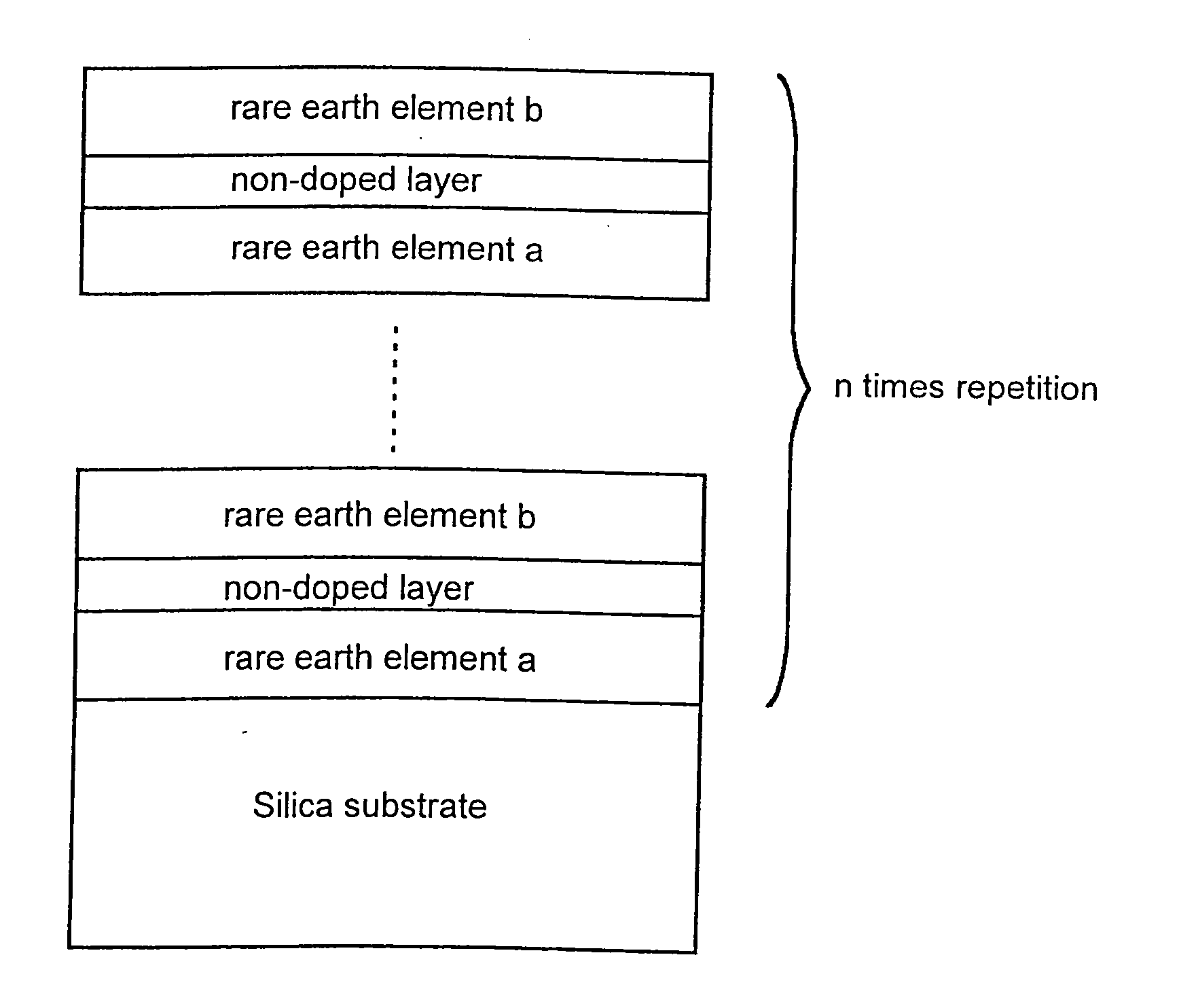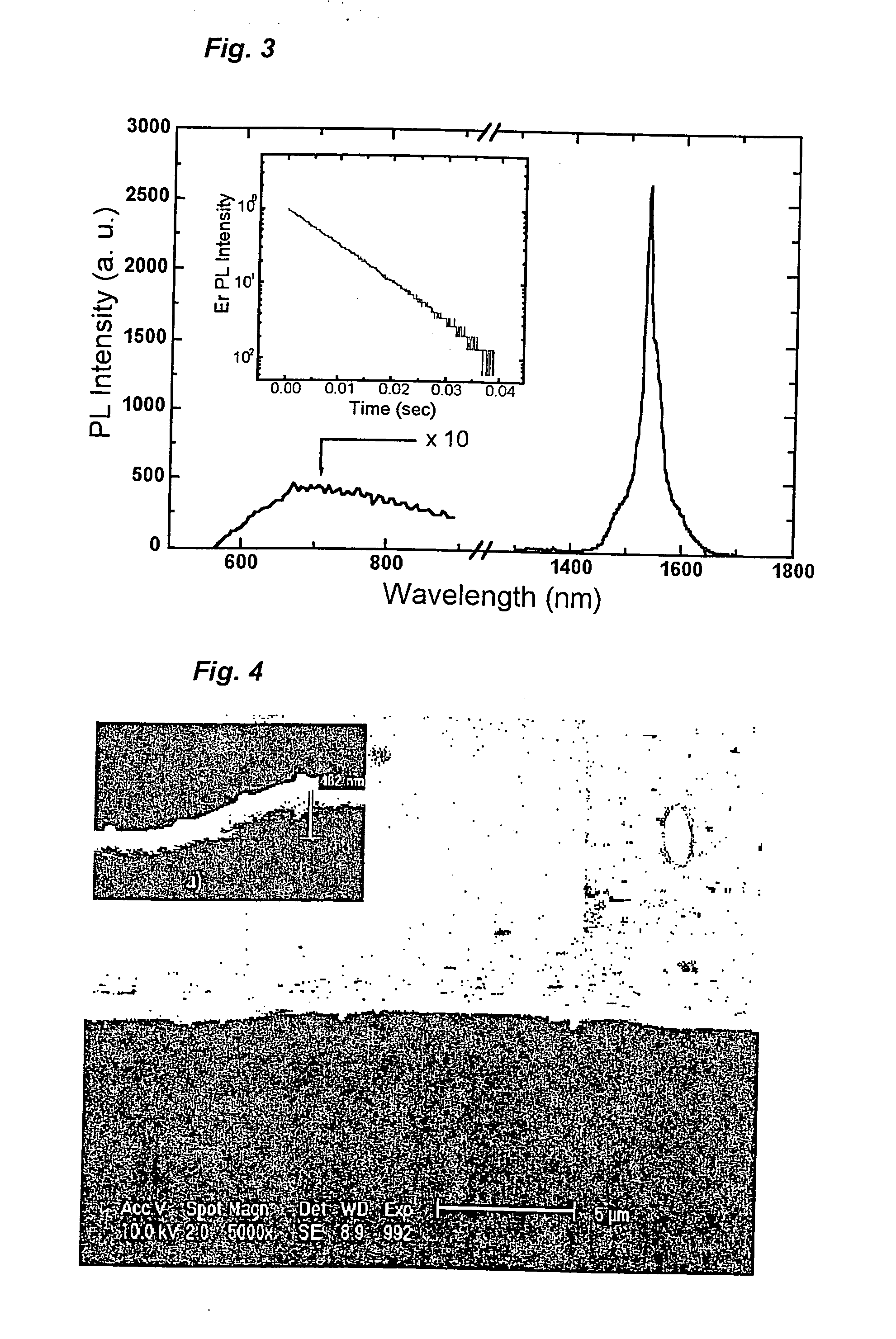Thin film for optical applications, light-emitting structure using the same and the fabrication method thereof
a technology of thin film and optical amplifier, applied in the direction of cladding optical fibre, optical waveguide light guide, active medium material, etc., can solve the problems of low luminous efficiency, low luminous efficiency of conventional rare earth-doped semiconductor, and high luminous efficiency of silica-based thin film, etc., to achieve high luminous efficiency and high excitation cross section
- Summary
- Abstract
- Description
- Claims
- Application Information
AI Technical Summary
Benefits of technology
Problems solved by technology
Method used
Image
Examples
first embodiment
[0032] First Embodiment
[0033]FIG. 3 is a graph showing the photoluminescence spectrum of a silica thin film for optical devices at room temperature according to the first embodiment of the present invention. The thin film comprising 35 atomic % of silicon, 65 atomic % of oxygen and 0.04 atomic % of erbium was chemical vapor deposited and heated at 1,000° C. for 5 minutes. As shown in FIG. 3, a luminescence peak of a silicon nanocluster was observed around 700 nm. The relationship between the position of the luminescence peak of the silicon nanocluster and the size of the silicon nanocluster is already known in the art. Based on this result, the average size of the silicon nanocluster in the thin film was calculated as 2 nm. In this case, the concentration of the silicon nanocluster was 7×1018 cm−3 and the concentration ratio of the doped erbium to the silicon nanocluster was 3. That is, it can be said that the thin film of FIG. 3 is manufactured according to the method of the presen...
second embodiment
[0047] Second Embodiment
[0048] In case of a silica or silica-based thin film which is co-doped with a silicon nanocluster and rare earth atoms, the rare earth atoms are excited through an electron-hole recombination formed in the silicon nanocluster regardless of the absorption band of the rare earth element. In this regard, in accordance with the second embodiment of the present invention, in case of doping various types of the rare earth elements on one thin film, it is possible to generate luminescence of various wavebands using one pump light source. FIG. 6 shows the photoluminescence spectra of silica thin films for optical devices doped with erbium and / or thulium. A pump light source of 488 nm wavelength was used alone. In FIG. 6, a solid line represents the thin film which is co-doped with erbium and thulium, a long dotted line represents the thin film which is doped with a high concentration of erbium, a short dotted line represents the thin film which is doped with a low co...
third embodiment
[0049] Third Embodiment
[0050] In case of using two types of rare earth elements according to the second embodiment of the present invention, these rare earth elements may interact with each other, thereby lowering the luminous efficiency. In order to solve this problem, it is necessary to dope the two types of rare earth elements on multiple silica layers in a manner such that one silica layer is doped with one type of a rare earth element (see FIG. 7a). Preferably, as shown in FIG. 7b, a non-doped silica layer can be sandwiched between the two types of rare earth elements. As a result, the two types of rare earth elements can be entirely prevented from interacting with each other. In this case, it is preferable to limit the thickness of each layer to 10 nm or less to ensure total uniformity of the thin film. FIGS. 7a and 7b are schematic cross sectional views showing the aforementioned thin film structures. It is understood that doping with two or more types of rare earth elements ...
PUM
| Property | Measurement | Unit |
|---|---|---|
| size | aaaaa | aaaaa |
| thickness | aaaaa | aaaaa |
| pressure | aaaaa | aaaaa |
Abstract
Description
Claims
Application Information
 Login to View More
Login to View More - R&D
- Intellectual Property
- Life Sciences
- Materials
- Tech Scout
- Unparalleled Data Quality
- Higher Quality Content
- 60% Fewer Hallucinations
Browse by: Latest US Patents, China's latest patents, Technical Efficacy Thesaurus, Application Domain, Technology Topic, Popular Technical Reports.
© 2025 PatSnap. All rights reserved.Legal|Privacy policy|Modern Slavery Act Transparency Statement|Sitemap|About US| Contact US: help@patsnap.com



